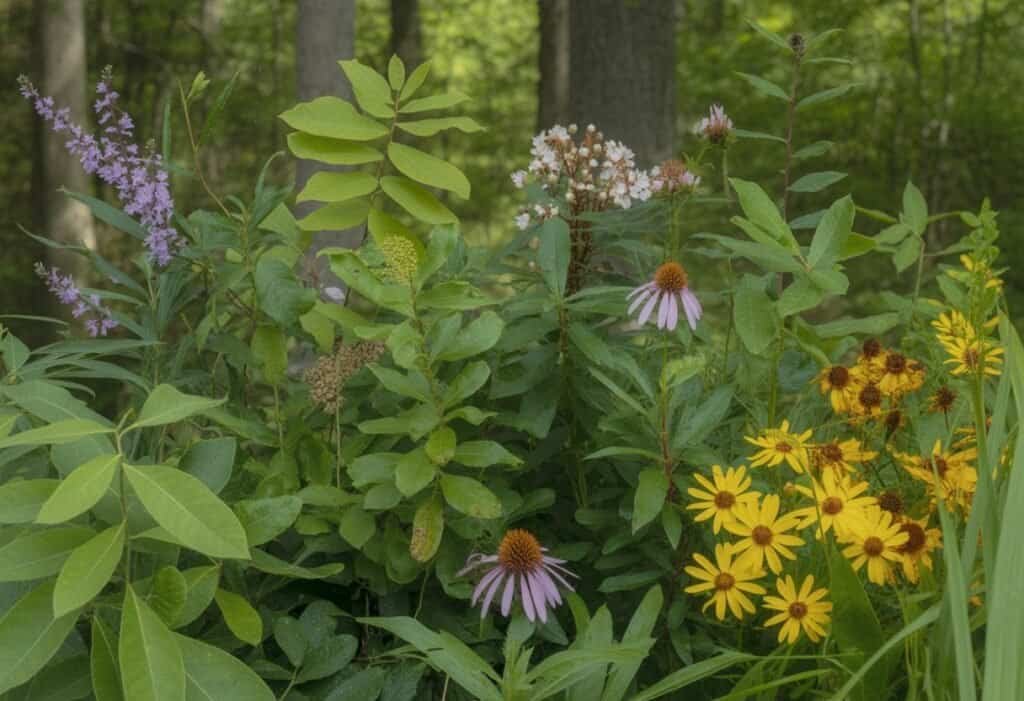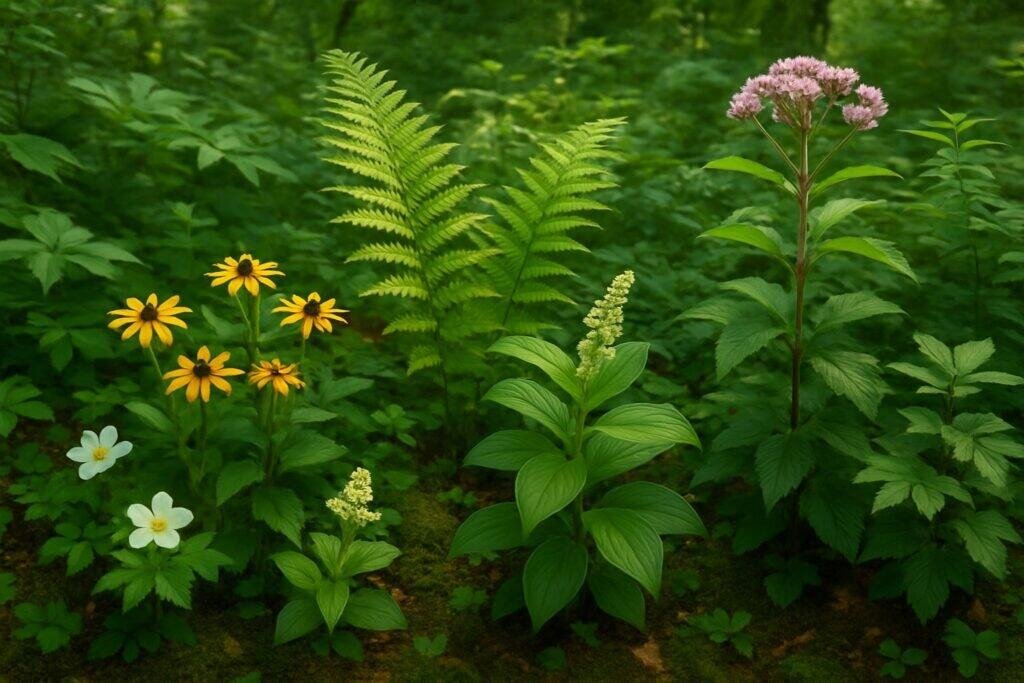Georgia native plants bring unmatched beauty and ecological value to our landscapes. These plants have evolved over thousands of years to thrive in our specific climate and soil conditions.
They are perfect choices for local gardens and natural areas.
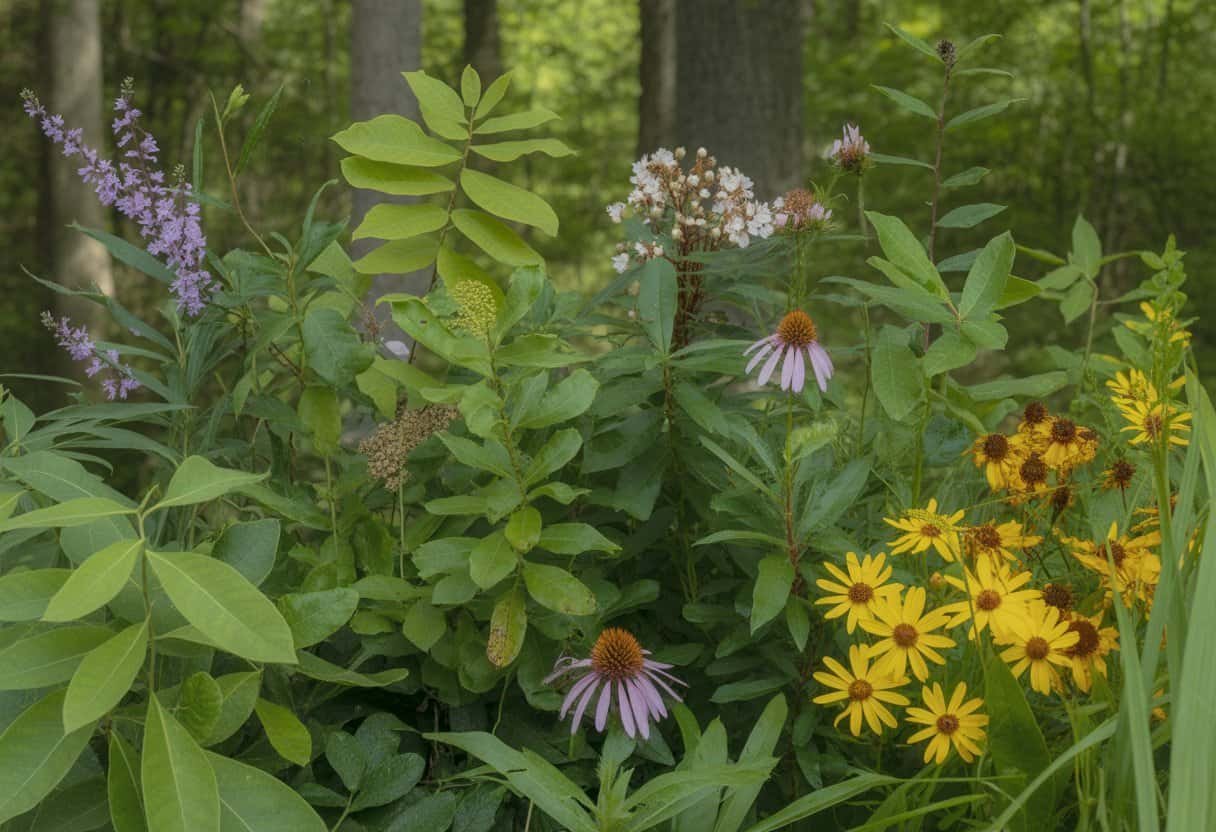
Native plants support Georgia’s wildlife by providing essential food and habitat for pollinators, birds, and other animals. They need less water, fertilizer, and maintenance than non-native species.
These plants have adapted to our hot summers, periodic droughts, and varied soil types across the state’s diverse regions. From the mountains to the coast, they connect us to Georgia’s natural heritage.
Key Takeaways
- Georgia native plants require less maintenance and resources while thriving in local growing conditions.
- Native species provide essential habitat and food sources for local wildlife and pollinators.
- Using indigenous plants helps preserve Georgia’s natural heritage and unique regional ecosystems.
Understanding Georgia’s Native Plants
Georgia’s native plants have evolved over thousands of years to thrive in the state’s unique soil conditions and climate patterns. They play crucial roles in maintaining healthy ecosystems and supporting diverse wildlife throughout the state.
Definition and Importance
Native plants are species that have naturally developed in Georgia’s landscapes without human introduction. They have adapted specifically to Georgia’s rainfall patterns, soil types, and temperature ranges over centuries.
The Georgia Native Plant Society defines native plants as those growing in the region before European settlement. Examples include trees like the Southern Magnolia, shrubs such as Oakleaf Hydrangea, and wildflowers like Black-eyed Susan.
Native plants preserve Georgia’s natural heritage and maintain the state’s botanical diversity. They form the foundation for healthy ecosystems.
Gardeners benefit from using native plants because they need less maintenance, fewer pesticides, and minimal fertilization once established. This makes them environmentally friendly and cost-effective.
Benefits for Local Ecosystems
Native plants strengthen Georgia’s ecosystems in several ways. Their deep root systems prevent erosion by holding soil in place during heavy rains.
These plants filter water pollutants, improving water quality in streams and rivers. Their natural adaptation to local conditions helps them withstand drought, flooding, and temperature extremes.
Native plants create balanced ecosystems. They have evolved alongside other native species, forming complex relationships that maintain natural checks and balances.
In urban areas, native plant gardens create “stepping stones” of habitat between larger natural areas. This connectivity allows wildlife to move safely through developed landscapes.
Native plant communities store carbon, helping to mitigate climate change impacts. They also provide natural beauty unique to Georgia’s landscape.
Role in Supporting Wildlife
Georgia’s native plants form the foundation of the food web for local wildlife. They provide essential nectar, pollen, seeds, fruits, and nuts that feed countless species.
Native pollinators like bees, butterflies, and hummingbirds depend on native plants. Monarch butterflies require milkweed plants to reproduce, while many native bee species feed only on specific native flowers.
Birds rely on these plants too. Cardinal Flower attracts hummingbirds, while serviceberry provides berries for over 40 bird species.
Even mammals benefit from native vegetation. Deer browse on native shrubs, and smaller mammals find shelter among native grasses and groundcovers.
Many wildlife species have co-evolved with specific plants, creating interdependent relationships. Certain butterfly species can only lay eggs on particular native host plants, making these plants essential for their survival.
Georgia’s Diverse Natural Environments
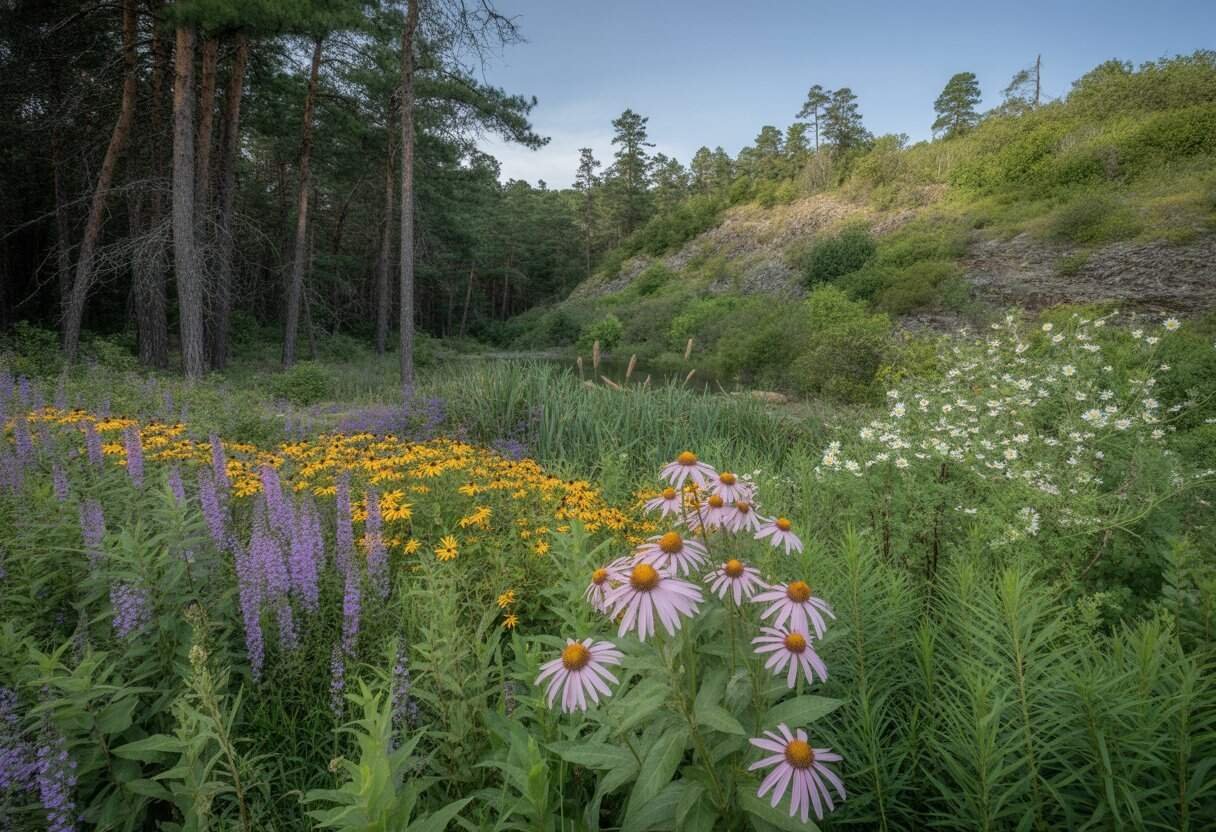
Georgia’s landscape features remarkable ecological diversity from the mountains to the coast. This variety creates distinct growing conditions that native plants have evolved to thrive within.
Hardiness Zones and Microclimates
Georgia spans USDA hardiness zones 6b through 8b, creating different growing environments across the state. The northern mountain region falls within zones 6b-7a, where winter temperatures can drop to 0°F.
The Piedmont area generally sits in zone 7b. Coastal Georgia enjoys the milder zone 8b with minimum temperatures rarely below 15°F.
Microclimates exist within these broader zones. Urban areas often run 5-10 degrees warmer than rural areas because of heat-retaining surfaces.
South-facing slopes receive more sunlight and warmth than north-facing areas. Water bodies like lakes and rivers moderate temperature extremes, and areas near the Atlantic coast experience less dramatic temperature swings.
Site Conditions and Adaptations
Native plants have adapted to Georgia’s varied site conditions through thousands of years of evolution. In the mountains, plants tolerate thin, acidic soils and temperature fluctuations.
Piedmont natives handle clay soils and seasonal drought. Coastal species thrive in sandy soils, tolerate salt spray, and survive occasional flooding.
Georgia’s heat and humidity create challenging growing conditions. Many native plants developed deep root systems to access groundwater during dry periods.
Some species thrive in specialized environments like:
- Swamps: Button bush and bald cypress with water-resistant trunks
- Beaches: Sea oats and beach morning glory with salt tolerance
- Rocky outcrops: Diamorpha and lichen that need minimal soil
Native plants often adapt to shade levels, soil moisture, and seasonal weather patterns within their natural habitats.
Native Trees of Georgia
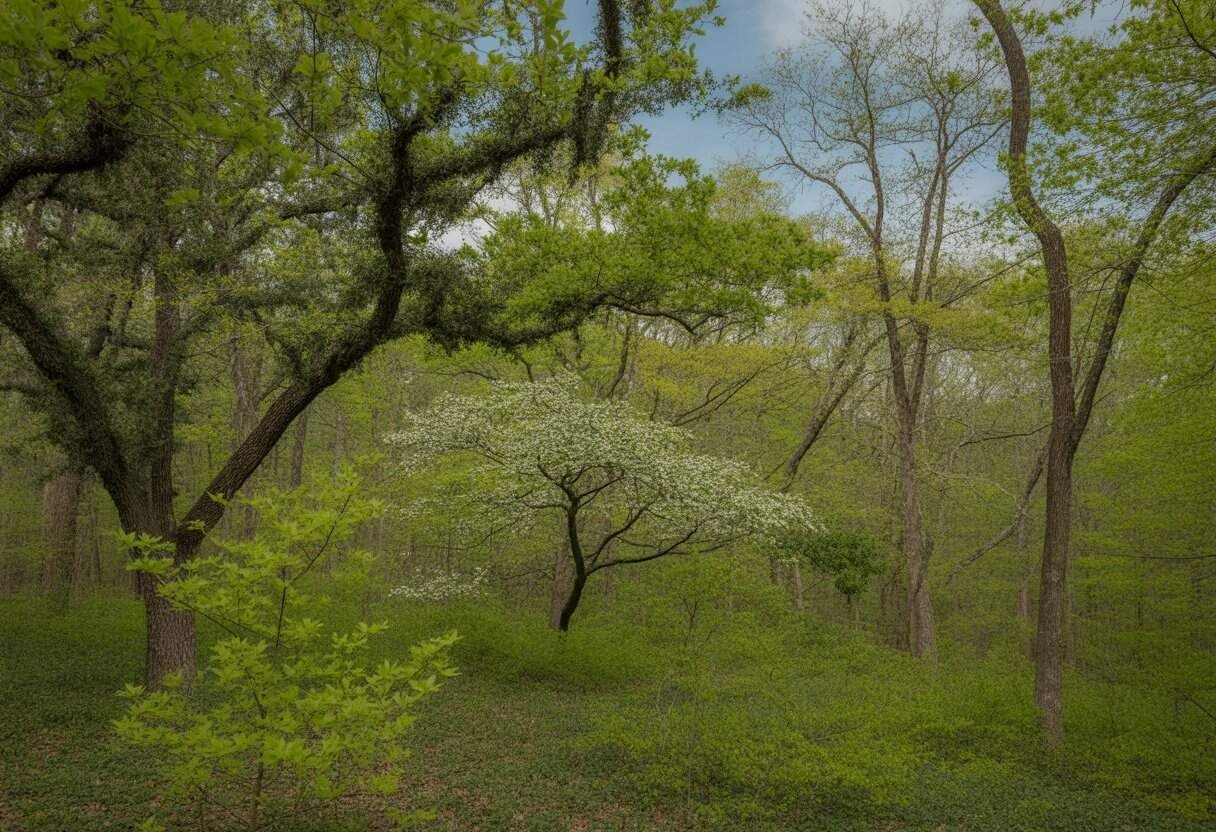
Georgia’s forests showcase a rich variety of native trees that thrive in the state’s diverse climate zones. These indigenous species provide essential habitat for wildlife and contribute to Georgia’s distinctive landscape character.
Iconic Canopy Trees
The loblolly pine dominates many Georgia forests and can grow up to 100 feet tall with distinctive scaled bark. This adaptable tree thrives in various soil conditions across the state.
The willow oak features narrow, willow-like leaves and reaches heights of 60-75 feet. It commonly grows in moist bottomlands and along streams.
Red maple displays brilliant scarlet fall color and adapts to many growing conditions. Its red flowers appear in early spring before leaves emerge.
Southern sugar maple grows mainly in northern Georgia. This medium-sized tree offers orange-yellow fall color and prefers upland sites with well-drained soil.
Southern magnolia stands as Georgia’s signature evergreen tree. Its large, glossy leaves and fragrant white blossoms make it instantly recognizable in southern landscapes.
Flowering and Ornamental Trees
Flowering dogwood ranks among Georgia’s most beloved native trees. Its white or pink spring blooms appear before the leaves, creating a stunning display in forest understories.
The eastern redbud announces spring with vibrant purple-pink flowers that emerge directly from branches. This small tree grows 20-30 feet tall and thrives in partial shade.
Serviceberry offers spring flowers, summer berries, and brilliant fall color. Birds eagerly eat its edible fruits.
Georgia’s native crabapples produce fragrant spring blossoms followed by small fruits that persist into winter. These hardy trees support numerous wildlife species.
Fringe tree displays unusual white, fringe-like blooms in late spring. This small native tree remains pest-resistant and adapts well to various landscape settings.
Shrubs and Woody Plants
Georgia’s landscape features a diverse array of native shrubs and woody plants. These plants provide wildlife habitat, seasonal interest, and low-maintenance beauty for gardens.
Key Native Shrubs
Bottlebrush Buckeye (Aesculus parviflora) stands out as one of Georgia’s most impressive native shrubs. This woodland plant can grow 8-12 feet tall with spreading branches and white flower spikes in summer.
American Beautyberry (Callicarpa americana) delivers year-round appeal in Georgia gardens. Its arching branches produce clusters of vivid purple berries in fall that persist after leaves drop.
Native hollies thrive throughout Georgia, especially American Holly (Ilex opaca). This evergreen can reach 40 feet tall in the wild but works well as a pruned shrub in landscapes.
These shrubs require minimal care once established. They have adapted to Georgia’s climate and soil conditions, making them drought-tolerant and resistant to local pests.
Azaleas, Rhododendrons, and Laurels
Native azaleas differ from Asian varieties commonly seen in landscapes. Georgia boasts several species, including the Flame Azalea (Rhododendron calendulaceum) with its bright orange-red blooms.
Native azaleas drop their leaves in winter and prefer dappled shade and acidic, well-drained soil. Their fragrant blooms attract butterflies and hummingbirds in spring.
Mountain Laurel (Kalmia latifolia) thrives in Georgia’s Piedmont and mountain regions. Its pink buds open to delicate white or pink flowers in late spring.
This evergreen shrub provides year-round structure in woodland gardens. Rhododendrons naturally occur in Georgia’s higher elevations and feature leathery leaves and showy flower clusters.
Both Mountain Laurel and native rhododendrons need protection from harsh afternoon sun and grow best in well-drained, acidic soil.
Wildflowers, Grasses, and Ferns
Georgia boasts a diverse array of native plant species that thrive in its varied ecosystems. These indigenous plants have adapted to local conditions over thousands of years.
They make resilient choices for gardens and natural landscapes throughout the state.
Georgia Native Wildflowers
Black-eyed Susan (Rudbeckia) stands out as one of Georgia’s most recognizable native wildflowers. Its bright yellow petals with dark centers bloom from early summer through fall and attract many pollinators.
Bloodroot (Sanguinaria canadensis) offers early spring blooms with delicate white flowers. This woodland plant gets its name from the red sap in its roots.
Cardinal flower (Lobelia cardinalis) produces vibrant red blooms that attract hummingbirds. This moisture-loving perennial thrives along stream banks and in wet meadows.
Native asters provide crucial late-season nectar for butterflies. These purple to blue daisy-like flowers bloom in fall when many other plants have finished flowering.
Goldenrod (Solidago) species brighten Georgia landscapes in late summer and fall. These plants support over 100 butterfly and moth species.
Native Grasses and Groundcovers
Blue-eyed grass (Sisyrinchium) isn’t actually a grass but a member of the iris family. This low-growing plant produces blue flowers in spring and forms tidy clumps for borders or rock gardens.
Native verbena spreads to form colorful mats of purple, pink, or white flowers. These drought-tolerant plants attract butterflies and provide excellent groundcover in sunny spots.
Little bluestem grass offers year-round interest with blue-green summer foliage that turns russet-orange in fall. This bunch grass requires minimal maintenance and provides winter habitat for birds.
Native sedges thrive in moist areas where traditional lawn grasses struggle. These adaptable plants help prevent erosion along waterways and create habitat for small wildlife.
Joe Pye weed (Eutrochium) grows tall in moist areas. Its mauve flower clusters appear in late summer, attracting butterflies and adding vertical interest to garden borders.
Ferns and Shade-Loving Species
Christmas fern stays evergreen through winter. It provides year-round structure in woodland gardens.
This tough native fern tolerates dry conditions better than many other ferns.
Cinnamon fern produces fertile fronds that look like cinnamon sticks rising from the plant’s center. In moist, shady spots, these ferns can grow up to three feet tall.
Maidenhair fern has delicate, fan-shaped fronds on black stems. It prefers rich, moist soil and dappled shade.
Black cohosh (Cimicifuga) sends up dramatic white flower spikes that brighten shady areas in summer. These woodland perennials can reach 4-6 feet tall and attract beneficial insects.
Native iris species thrive in both sunny and partially shaded places. These flowers range from the small crested iris to the bold southern blue flag iris, which does well in wet areas.
Vines and Woody Climbers
Georgia’s landscape features several native vines and woody climbers. These plants add vertical interest to gardens and support local wildlife.
They can turn fences, arbors, and trees into living walls of greenery and flowers.
Popular Native Vines
Crossvine (Bignonia capreolata) stands out with trumpet-shaped orange-red flowers that bloom in spring. This vigorous vine uses small tendrils to attach to surfaces and can reach 30-50 feet tall.
Coral honeysuckle (Lonicera sempervirens) offers tubular red flowers that attract hummingbirds from spring through fall. This native vine behaves well in gardens and provides valuable nectar.
Carolina jessamine (Gelsemium sempervirens) produces fragrant yellow flowers in early spring. This semi-evergreen vine grows 10-20 feet tall and works well on trellises and fences.
Virginia creeper (Parthenocissus quinquefolia) provides spectacular fall color when its five-leaflet foliage turns bright red. It climbs using adhesive discs and does not damage structures.
Attracting Pollinators and Wildlife
Native vines offer habitat and food for Georgia wildlife. Crossvine and coral honeysuckle attract hummingbirds with their tubular flowers.
Trumpet creeper (Campsis radicans) draws hummingbirds and butterflies with bright orange blooms. This strong climber needs sturdy support and regular pruning.
Passionflower (Passiflora incarnata) hosts caterpillars of the gulf fritillary butterfly and produces unusual purple flowers. The vine also bears edible fruits called maypops.
Berries from native vines like Virginia creeper feed birds in fall and winter. Dense foliage from mature vines provides nesting sites and shelter for wildlife.
Principles of Native Landscaping in Georgia
Creating a Georgia native landscape combines beauty with ecological benefits. Native plants thrive in local conditions, support wildlife, and need fewer resources.
Plant Selection and Design
When choosing native plants, consider your site conditions. Most Georgia properties have clay or sandy soils, so match your plant choices to your soil.
Group plants with similar water needs to create efficient watering zones. This practice, called hydrozoning, reduces maintenance and water use.
Native trees like oaks, maples, and dogwoods form the backbone of your landscape. They provide shade, wildlife habitat, and fall color.
For shrubs, try Georgia natives like oakleaf hydrangea, Virginia sweetspire, and beautyberry. These offer flowers, berries, and fall color.
Use native perennials like coneflowers, black-eyed Susans, and Georgia asters as ground-level plants. Once established, these require little maintenance.
Creating Wildlife-Friendly Gardens
Wildlife-friendly gardens provide food, water, shelter, and nesting sites. Your plant choices affect how many birds, butterflies, and insects visit your garden.
Include nectar plants like bee balm, joe-pye weed, and native milkweeds for pollinators. These plants offer flowers rich in nectar and pollen.
Berry-producing plants attract birds and provide natural food. Good choices include:
- American beautyberry
- Serviceberry
- Native viburnums
Create plant layers in your landscape by combining trees, shrubs, and ground covers. This gives wildlife diverse shelter options.
Leave some garden areas less tidy in fall and winter. Dead stems and leaf litter offer winter shelter for insects and small wildlife.
Planting, Care, and Seasonal Maintenance
Georgia native plants thrive with proper planting and minimal care. They have adapted to local conditions over thousands of years and become resilient once established.
Establishing Native Plants
Choose the right spot for each plant based on sun, soil, and moisture needs. Most Georgia natives do best when planted in fall or early spring.
Dig holes twice as wide as the root ball but not deeper. This helps roots spread into the surrounding soil.
Remove plants from containers and gently loosen bound roots before planting. Apply 2-3 inches of mulch around new plants, keeping it away from stems.
Mulch helps retain moisture and suppress weeds. Water thoroughly after planting, giving about one inch of water weekly during the first growing season.
Most native plants build strong roots within 1-2 years. During this time, they need more attention than after they are established.
Drought Tolerance and Watering
Once established, many Georgia natives show excellent drought tolerance. Plants like butterfly weed, purple coneflower, and Georgia aster can survive long dry spells with little extra water.
Watering Guidelines:
- Year 1: Water weekly if rainfall is low.
- Year 2: Water during long dry periods (2+ weeks without rain).
- Year 3+: Water only during severe drought.
When you water, do so deeply and less often. This encourages deep root growth and drought resilience.
A rain garden can use natural rainfall and reduce irrigation needs. Native plants like cardinal flower, swamp milkweed, and river oats do well in these wet spots.
Sustainable Maintenance Practices
Georgia natives need little fertilizer once established. If needed, use a light layer of organic compost in spring instead of chemical fertilizers.
Leave plant stems standing through winter. Seed heads feed birds, and hollow stems provide nesting sites for insects.
Cut back dead growth in early spring before new growth starts. Prune flowering shrubs like azaleas right after blooming to protect next year’s flower buds.
Control weeds with regular mulching and hand-pulling. Avoid herbicides to protect beneficial soil life and prevent chemical runoff.
Noteworthy Native Species to Explore
Georgia’s diverse landscapes host many remarkable native plants. These species offer beauty, ecological benefits, and a link to the state’s natural heritage.
Rare and Lesser-Known Species
American Snowbell (Styrax americanus) grows as a shrub or small tree reaching 6-10 feet tall. Its fragrant white bell-shaped flowers bloom in spring against dark green leaves.
Bigleaf Magnolia (Magnolia macrophylla) has the largest simple leaves of any native North American tree, sometimes up to 30 inches long. This rare magnolia produces large creamy-white flowers with purple centers in late spring.
Carolina Silverbell (Halesia carolina) displays clusters of white bell-shaped flowers that dangle from branches in April. This understory tree thrives in part shade and moist, well-drained soils.
Persimmon (Diospyros virginiana) offers glossy foliage, interesting bark, and sweet orange fruits after frost. Wildlife enjoy these fruits as a food source.
Understory Plants and Specialty Natives
American Beautyberry (Callicarpa americana) produces clusters of vibrant purple berries that circle stems in fall. This shrub grows 3-5 feet tall and tolerates many soil types.
Native azaleas are great for Georgia gardens. These deciduous shrubs offer fragrant blooms in colors from white to vivid orange.
Georgia Aster (Symphyotrichum georgianum) shows violet-purple flowers in October when few other plants bloom. This rare perennial has declined in the wild but grows well in gardens.
Wild Ginger (Asarum canadense) makes an excellent groundcover for shady spots with its heart-shaped leaves. Its maroon flowers appear at ground level in spring, often hidden by the foliage.
Frequently Asked Questions
Georgia native plants provide many benefits for local landscapes and ecosystems. Here are answers to common questions about using these species in your garden or property.
What are some popular native plants used for landscaping in Georgia?
Popular Georgia native plants include Eastern Redbud trees with vibrant spring flowers and heart-shaped leaves. Oakleaf Hydrangea shrubs offer dramatic foliage and summer blooms.
Cherokee Rose and Carolina Jasmine add climbing elements with showy flowers. Black-eyed Susans and Purple Coneflowers give reliable summer color and attract pollinators.
For shady spots, Christmas Fern and Autumn Fern offer evergreen texture. These plants need less maintenance than non-natives and support local wildlife.
How can I identify native plants in Georgia?
Field guides for Georgia or the Southeast provide detailed descriptions and images of native plants. The Georgia Native Plant Society offers printed resources and online databases with photos and identification tips.
Mobile apps like iNaturalist or PlantNet let you take photos for instant identification. Key features include leaf arrangement, flower structure, bark patterns, and growth habits.
Notice plant communities that grow together naturally, as this can help with identification. Native plant nurseries often label their plants with both common and scientific names.
What is the best time of year to plant native species in Georgia?
Fall is usually the best time to plant most Georgia natives. Cooler temperatures and more rain help roots grow before summer heat arrives.
Early spring is the next best time. Avoid planting in summer when heat can stress new plants.
Some native seeds need cold treatment and should be planted in late fall or winter. Check specific advice for each species, as timing can vary.
Where can I buy native plants in Georgia?
Specialized native plant nurseries like Nearly Native Nursery in Fayetteville and Baker Environmental Nursery in Alpharetta offer many choices. The Georgia Native Plant Society holds plant sales throughout the year.
Many garden centers now have native plant sections. Look for annual native plant sales at places like the State Botanical Garden of Georgia in Athens.
Online retailers specializing in native plants can ship species suited to Georgia’s climate. Make sure plants are nursery-propagated, not wild-collected.
Which native Georgia plants are effective for ground cover?
Creeping Phlox creates a carpet of purple, pink, or white flowers in spring and needs little care. Green-and-gold offers bright yellow blooms and semi-evergreen foliage in partial shade.
Wild Ginger covers woodland gardens well with its kidney-shaped leaves. Partridge Berry forms a dense mat with tiny red berries that last through winter.
For sunny areas, Dwarf St. John’s Wort offers yellow summer flowers and drought tolerance. Native sedges like Pennsylvania Sedge can replace lawn grasses in shady spots.
What is the designated state wildflower of Georgia?
The Cherokee Rose (Rosa laevigata) is Georgia’s official state floral emblem. Lawmakers designated it in 1916.
This climbing rose produces fragrant white flowers with yellow centers in spring. Despite its name and status, botanists classify the Cherokee Rose as non-native.
The plant originated in China. It became naturalized in Georgia centuries ago and holds cultural significance.
The state wildflower, which is different from the floral emblem, is the native Azalea (Rhododendron species). These deciduous shrubs produce spectacular spring blooms in colors ranging from white to vivid orange-red.

